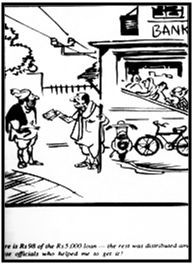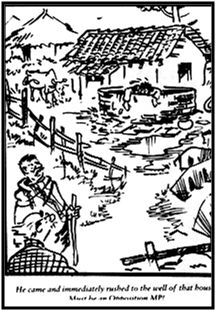Creation and Criticism
ISSN: 2455-9687
(A Quarterly International Peer-reviewed Refereed e-Journal
Devoted to English Language and Literature)
Vol. 01, Issue 01: April 2016

‘Showing’ versus ‘Telling’: R.K. Narayan’s Verbal and R.K. Laxman’s Visual Narratives
Dr. Sandhya Saxena
Abstract:
Narayan's fictional narratives are marvellous discourses in words while Laxman's sketches are invested with the exclusivity of relating a tale through simple strokes of a pencil. Laxman sketches what Narayan narrates. Art becomes a universal language in conveying the message in the hands of Laxman who makes the reader visualise a collective culture. Laxman's non-fictional narrative and Narayan's fictional narrative are the two lenses to view the world. With his discourses in words Narayan reproduces the graphics corresponding to Laxman's visual slides.
Key words: Sign, symbol, graphics, the visual image, narratives, cartoons, discourses
Signs and symbols – both verbal and visual are deployed to represent the symbiotic relationship that man has established with the world of reality around him. With the help of these signs and symbols an artist composes the document of the culture he represents. The process of this documentation involves conscious, deliberate and sometimes spontaneous representation of imagery which is a “means of expression, reinforcement, endorsement, illustration, evocation as also as objective correlative” (Alam 1). The decoding of this imagery provides a peep into an artist's creative cosmos which he draws with the help of either verbal or visual narrative. The narrative that relates a story, besides conveying an implicit message “is a particular form of representation, implementing signs” (Cobley 3). These signs are configured to constitute verbal or non-verbal language. Verbal signs or words constitute verbal language to produce a fictional narrative conveying a message in verbal medium while non-verbal signs, like lines and figures, compose non-verbal language to convey a visual message: The message consists of a 'story': a succession of fictional events or sequences of events along with the characters participating in them (Ramana, 13).
The novels of R.K. Narayan are widely and profoundly studied to trace the verbal message contained in them. Narayan is often considered to be an artist with ‘resolved limitations’. He is content like Jane Austen with his little bit of ivory just so many inches wide; he would like to be a detached observer to concentrate on a narrow scene to sense the atmosphere of the place to show a small group of characters in the oddities and angularities. (ramtake xviii)
If superficially studied, Narayan appears to be a traditional story teller concerned with only those he is intimately familiar with. It seems that the world beyond Malgudi does not even exist for him. However, an in-depth study decodes a significant verbal message implicit in his stories. A literary artist cannot be entirely detached and objective like a scientist. His observations may be restrained and controlled, but not without concern, as Northrop Frye has remarked: It (Literature) shows a concern over the situation of man in society, his place in the universe and his ultimate destiny. The humanities and social sciences show a similar concern, but literature does this through an intense vision. Literature is not detached but concerned (Ramtake xxii). In order to comprehend the verbal message implanted in the novels of Narayan it becomes 'imperative to decode the message being conveyed by the narratives.
In case of an author like Narayan, who writes light, humorous and ironic narratives about ordinary and comparatively insignificant aspects of South Indian middle class life, the study of themes or events alone would not reveal the message implicit in the narratives. On the surface level, the events, characters, themes and descriptions do not appear anything more than entertaining and readable stuff. But, still even his novels and short stories express a worldview (Ramana, 32).
Beginning with Swami and Friends, each successive novel of R.K. Narayan reveals his concern with society and his commitment to socio- political reality of the contemporaneous world like his cartoonist brother R.K. Laxman's commitment to socio- political issues of the day. However their approach to the existing socio- political scenario articulates their individuality and carries a distinct stamp of their modes of expression. Unlike ‘the bold and daring political commentary and laughter- provoking cartoons’ (Bhandari 17) of Laxman, Narayan's tales of Indian common man are garbed comments on the changes and upheavals stirring Indian society.
Laxman's 'sharp and pointed observations on the rampant corruption, social injustice, financial fiascos and political byplays that have plagued the nation since its inception' (Brushing, Cover page) equally unravel his anguished soul. His common man cartoons concentrate on the existing political rot and its impact on the socio- economic life of the country. His cartoons are collected to draw a chequered history of India in the volume entitled Brushing up the Years; A Cartoonist's History of India; 1947 to the Present (2000). As a political cartoonist, Laxman has mischievously commented on party politics, split in parties, economic and foreign policies of the government, taxation policy, un-kept promises of the politicians, booth capturing, hung parliaments, political alliances, rampant corruption at all levels and so on. In the midst of these political upheavals, the cartoonist keeps a penetrating eye on the plight of the Common Man of India, and disentangles his deceptive resignation to the contemporary situation. The political comments of Laxman lay bare the masked face of the contemporary reality; the day to day problems of common man like water shortage, poor sanitary conditions, road repairs, telephone disorders, the irregularities in construction activities, demonstrations, bomb blasts, and so on. Both the artists employ verbal and non- verbal signs to create images of contemporary culture.
Whatever symbols and signs an artist may deploy the represented images is largely influenced by, and also influences the contemporary culture. Narayan's verbal and Laxman's visual signs and symbols create images of the contemporary culture represented in -myriad vicissitudes targeting the common man of India at various levels. "For the common man, taps still run dry without water, phone connections still don't work, the price of vegetables keeps soaring higher, and postal delays remain persistent." (Apsa 303) These vicissitudes are drawn through verbal and non- verbal narratives in Narayan's fiction and Laxman's graphics. The non- verbal narratives that Laxman draws with the help of lines seem to be an illustration of the verbal narratives that Narayan portrays through words and vice- versa. This kinship between the aesthetic representations of the two artists owes a lot to the contemporary culture.
The contemporary culture of futile pledges and vain promises is subtly commented through the verbal signs in Narayan's The Man- Eater of Malgudi: the Deputy Minister who lays the foundation of veterinary college and animal welfare hospital is not the least interested in the project. So it is destined not to go beyond the foundation- laying ceremony. Narayan draws a verbal image of the project which suffers a set back because of the apathy of the ministers and officials:
......a Deputy Minister had laid the foundation for a veterinary college and animal welfare hospital on the other bank of the Sarayu, for which ten acres of land had been gifted by the municipality; some foundation had given dollars and equipment for a start, and the Government had promised to take the hospital under its wing during the Third Five- Year Plan and so on and so forth. (Man- Eater, 92)
In order to represent the reality of these projects he continues:
The question is full of politics. People do not want it here, but somewhere else. Our Deputy Minister has no interest in the project and so it goes on at its own pace. (Man- Eater, 94)
 A similar image is drawn through visual signs and symbols in Laxman's drawing, shown here: There he is! He comes regularly every year to lay the foundation stones for new projects: hydroelectronic, housing, industrial complex etc…! (Very Best 18)
A similar image is drawn through visual signs and symbols in Laxman's drawing, shown here: There he is! He comes regularly every year to lay the foundation stones for new projects: hydroelectronic, housing, industrial complex etc…! (Very Best 18)
The visual image drawn here lays bare the futility of laying foundation stones for the projects which are never accomplished. The foundation stone laid by some minister as an election stunt becomes the resting place for villagers while the surrounding area provides a grazing field to the cattle. The Common Man with his gesture of sardonic bewilderment conveys that he is accustomed to these instances of false promises and unaccomplished projects. With verbal and visual signs the two craftsmen constitute and communicate their representations of the world around them. A profound probing into their represented images reveals layers of narrative which “maintains the fragile distinction between ‘showing’ and ‘telling’...” (Cobley 6). Reading and re- reading the represented images of Laxman and narayan, one finds that this fragility of distinction between 'showing' (the visual) and 'telling' (the verbal) is often broken, making visual images look like the verbal and the verbal assuming the form of the visual.
 The visual images in Laxman's cartoons have a story to tell; the graphic details contain hordes of meaning to be conveyed to the people. These constitute the underlying narrative in an image created by visual signs and symbols. Laxman's visual narratives dare not cross the threshold set for graphic portrayal. They don't seem to theorise or predict a wayout of the impass. They just leave the reality unmasked before the people without instructing them to choose any path for the resolution of the problems.
The visual images in Laxman's cartoons have a story to tell; the graphic details contain hordes of meaning to be conveyed to the people. These constitute the underlying narrative in an image created by visual signs and symbols. Laxman's visual narratives dare not cross the threshold set for graphic portrayal. They don't seem to theorise or predict a wayout of the impass. They just leave the reality unmasked before the people without instructing them to choose any path for the resolution of the problems.
At places the narrative in Narayan's novels and the graphic drawings of Laxman seem to be an illustration of each other, if studied at close quarters. The cartoon (Mantri 127) is drawn to satirize corruption and red- tape practices in banking sector. The Common Man seems to be indifferently absorbed into his own business, though overhearing the comment of the loan seeker: “Here is Rs. 98 of the Rs. 5,000 loan – the rest was distributed among those officials who helped me to get it!” (Mantri 127)
The sardonic smile on the face of the loan- receiver reveals the mute resignation of poor Indians to the corruption prevailing in society. The text directly satirizes corruption. The Common Man does not speak at all. No text enumerates his response except for the gesture of 'silent bewilderment' that articulates the helplessness of common Indians. All are victimized to corruption prevalent in Indian society yet none initiates to uproot the dragon. Laxman's legendary Common Man seems to have adapted himself to this bitter reality of existence.
The derisive laughter on the face of the loan receiver, the lack of amazement on the face of the hearer, passive indifference of the Common Man are the signs that strengthen the narrative and the message of the visual image. If this visual graphic is set against the following narrative in Narayan's The Financial Expert, it will appear to be simply a continuation of Laxman's drawing:
The clerks of the bank had their own methods of worrying the villagers. A villager who wanted to know his account had to ask for it at the counter and invariably the accounts clerk snapped back, "Where is your pass-book?" A pass-book was a thing the villager could never keep his hand on. If it was not out of sight it was certain to be out of date. This placed the villager fully at the mercy of the clerk, who would say: "You will have to wait till I get through all the work I have now on hand. I'm not being paid to look after only your business here." And then the peasant would have to hang about for a day or two before getting an answer to his question, which would only be after placating the clerk with an offering in cash or kind. (Financial 3)
Laxman's non-fictional narrative and Narayan's fictional narrative are a dominant way for seeing the world. With his discourses in words Narayan reproduces the graphics corresponding to Laxman's visual slides. In the course of his novels often the narrative comes to a halt with the punch line similar to that of Laxman's in his graphic images. Sometimes these verbal images contain the essence of satiric humour as the episode in The Bachelor of Arts. Chandran made schedules for his study but could not follow them because of some or the other activity that kept him thoroughly engaged. The following verbal slide records his father's comment which is pricking as well as amusing:
Father, who appeared to be reading a newspaper in the veranda, exclaimed: "So after all!" this remark disturbed Chandran. But he remained silent, hoping that it would discourage his father from uttering further remarks. Father, however, was not to be kept off easily. The newspaper rustled on the veranda, and five minutes later came the remark: "Since this is the third time you have made a resolution, it is likely you would stick to it, because every plan must have two trials." (Bachelor 40)
Father's 'puckish, teasing' remark provides the punch line of Laxman's cartoons. The visible displeasure of Chandran at the initial reaction of his father results from his failure to follow previous 'whirlwind programme of study'. (39) The ensuing silence filled with the rustling of newspapers is tattered with the final remark from the father. The entire verbal picture is imbued with the mischievous spirit that marks Laxman's cartoons and has a story to tell.
A fictional narrative is a product of both narrative and non- narrative text which includes the description of persons and places. In order to understand the fictional narrative in its entirety the message contained in the non narrative text in equally imperative and needs to be decoded essentially. The following verbal image from Swami and Friends is worth consideration:
'Swaminathan moved away and waited under a tree. The sun was beating down fiercely. The street was almost deserted. A donkey was standing near a gutter, patiently watching its sharp shadow. A cow was munching a broad, green, plantain leaf. Presently Mani sneaked out of his house... (Swami 28)
The image of Mani, sneaking out his house sums the essence of the graphic details drawn to test Swami's patient and passionate waiting. The non- narrative text like fierce sun, deserted streets etc. between the two images; of Swami, waiting under a tree and, Mani, sneaking out of his house, essentially convey Swami's indispensable and irresistible urge for drinking Saturdays and Sundays to the lees.
 Likewise, in Laxman's cartoons the over- arching story which governs the image is embellished with the moulding of expressions visible on the face of the Common Man. The expressions like silent bewilderment, passive resignation, mute acceptance of life's predicament, ironic irreverence to the humdrum of life and others, sometimes arouse humour to provide a moment of reconciliation while at the other occasions they articulate the Common man's subconscious revolt against the system. Laxman often uses commonly comprehended metaphors and symbols to relate a story against the contemporary political setting. Laxman's famous 'rushing to the well' cartoon is remarkable for the use of commonly and instantly understood signs. Rushing to the well of the House to protest is of course a quintessentially Indian parliamentary phenomenon. The image drawn with simple brushstrokes in the shown figure very aptly presents the common 'rush to well' sign. The text line, 'He came and immediately rushed to the well of that house! Must be an Opposition MP!... accomplishes the language (Very Best 32).
Likewise, in Laxman's cartoons the over- arching story which governs the image is embellished with the moulding of expressions visible on the face of the Common Man. The expressions like silent bewilderment, passive resignation, mute acceptance of life's predicament, ironic irreverence to the humdrum of life and others, sometimes arouse humour to provide a moment of reconciliation while at the other occasions they articulate the Common man's subconscious revolt against the system. Laxman often uses commonly comprehended metaphors and symbols to relate a story against the contemporary political setting. Laxman's famous 'rushing to the well' cartoon is remarkable for the use of commonly and instantly understood signs. Rushing to the well of the House to protest is of course a quintessentially Indian parliamentary phenomenon. The image drawn with simple brushstrokes in the shown figure very aptly presents the common 'rush to well' sign. The text line, 'He came and immediately rushed to the well of that house! Must be an Opposition MP!... accomplishes the language (Very Best 32).
Narayan's fictional narratives are marvellous discourses in words; simultaneously Laxman's sketches are invested with the exclusivity of relating a tale through simple strokes of a pencil. Narayan's fabulous gift of story- telling creates tales which are beyond times and, Laxman's fantastic draftsmanship comprises the verbal into the visual– a single sketch which conveys the essence of the story. Through their different tools (Words & Lines) the two versatile artists see things differently; and see things that are most unnoticeable to others. What Narayan narrates through words, Laxman draws with lines; thus conveying the message that art is a universal language that imparts a shared vision to visualize a collective culture.
Works Cited:
Alam, Quaiser Zoha.: The Dynamics of Imagery (The Image in Indian English Literature). New Delhi: Atlantic Publishers & Distributors, 1994. Print.
Bhandari, Dharmendra: R.K. Laxman- The Uncommon Man- Collection of Works 1948 to 2008. Jaipur: Jaipur Printer Pvt. Ltd., 2009. Print.
Chatterjee, Sushmita: Cartooning Democracy: The Images of R.K. Laxman. Political Science and Politics (Pub. By apsa) April, 2007. Print.
Cobley, Paul: Narrative. London & New York: Routledge- Taylor & Francis Group, 2001. Print.
Laxman, R.K. The Best of Laxman; The Common Man Meets the Mantri. New Delhi: Penguin Books India, 2000. Print.
---. The Very Best of the Common Man. New Delhi: Penguin Books India, 2012. Print.
---. Brushing up the Years: A Cartoonist's History of India: 1947 to the Present (2000). New Delhi: Penguin Books India, 2008. Print.
Narayan, R.K. The Financial Expert. Chennai: Indian Thought Publications, 2010. Print.
---. The Man- Eater of Malgudi. Chennai: Indian Thought Publications, 2003. Print.
---. The Bachelor of Arts. Chennai: Indian Thought Publications, 2011. Print.
---. Swami and Friends. Chennai: Indian Thought Publications, 2012. Print.
Ramana, P.S.: Message in Design: A Study of R.K.Narayan's Fiction. New Delhi: Harman Publishing House, 1993. Print.
Ramtake, S.R.: R.K. Narayan and His Social Perspective. New Delhi: Atlantic, 2008. Print.
About the Contributor:
Dr Sandhya Saxena is an Associate Professor in the Department of English at V.R.A.L. Govt. Mahila Mahavidyalaya, Bareilly. She has completed 15 years of teaching in Govt. Colleges. She has edited and co-edited three books, namely: Political Novel: The Beaten Track & the Path Ahead, Five Indian Women Writers: A Feminist Vision, Text Book of English Prose. Her quality research papers have been published in reference books and esteemed journals like Replica, Cyber Literature, Contemporary Vibes, Labyrinths and The Indian Journal of English Studies. She has completed a Major Research Project on Words Vs Lines: A Comparative Study of R.K.Narayan's Lingual & R.K.Laxman's Graphic Representation of Humanity. She can be contacted at sandhyapranav73@yahoo.com.


